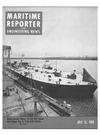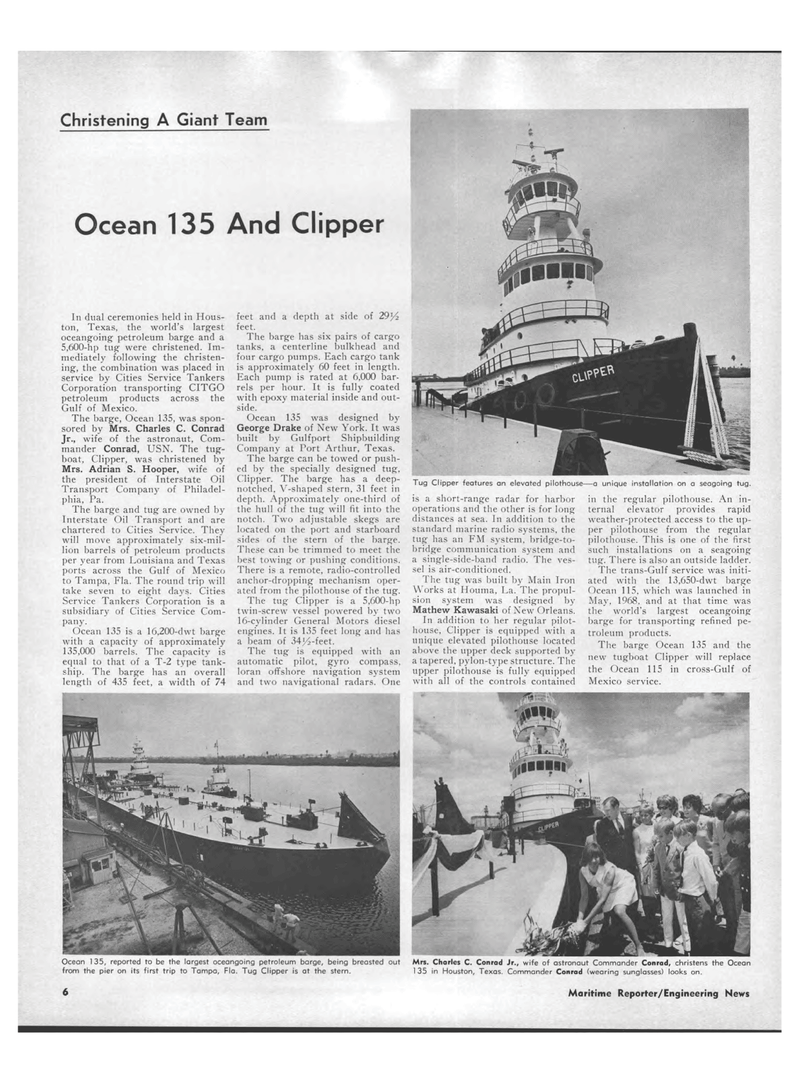
Page 4: of Maritime Reporter Magazine (July 15, 1969)
Read this page in Pdf, Flash or Html5 edition of July 15, 1969 Maritime Reporter Magazine
Christening A Giant Team Ocean 135 And Clipper In dual ceremonies held in Hous-ton, Texas, the world's largest oceangoing petroleum barge and a 5,600-hp tug were christened. Im-mediately following the christen-ing, the combination was placed in service by Cities Service Tankers Corporation transporting CITGO petroleum products across the Gulf of Mexico. The barge, Ocean 135, was spon-sored by Mrs. Charles C. Conrad Jr., wife of the astronaut, Com-mander Conrad, USN. The tug-boat, Clipper, was christened by Mrs. Adrian S. Hooper, wife of the president of Interstate Oil Transport Company of Philadel-phia, Pa. The barge and tug are owned by Interstate Oil Transport and are chartered to Cities Service. They will move approximately six-mil-lion barrels of petroleum products per year from Louisiana and Texas ports across the Gulf of Mexico to Tampa, Fla. The round trip will take seven to eight days. Cities Service Tankers Corporation is a subsidiary of Cities Service Com-pany. Ocean 135 is a 16,200-dwt barge with a capacity of approximately 135,000 barrels. The capacity is equal to that of a T-2 type tank-ship. The barge has an overall length of 435 feet, a width of 74 feet and a depth at side of 29y2 feet. The barge has six pairs of cargo tanks, a centerline bulkhead and four cargo pumps. Each cargo tank is approximately 60 feet in length. Each pump is rated at 6,000 bar-rels per hour. It is fully coated with epoxy material inside and out-side. Ocean 135 was designed by George Drake of New York. It was built by Gulfport Shipbuilding Company at Port Arthur, Texas. The barge can be towed or push-ed by the specially designed tug, Clipper. The barge has a deep-notched, V-shaped stern, 31 feet in depth. Approximately one-third of the hull of the tug will fit into the notch. Two adjustable skegs are located on the port and starboard sides of the stern of the barge. These can be trimmed to meet the best towing or pushing conditions. There is a remote, radio-controlled anchor-dropping mechanism oper-ated from the pilothouse of the tug. The tug Clipper is a 5,600-hp twin-screw vessel powered by two 16-cylinder General Motors diesel engines. It is 135 feet long and has a beam of 34j^-feet. The tug is equipped with an automatic pilot, gyro compass, loran offshore navigation system and two navigational radars. One is a short-range radar for harbor operations and the other is for long distances at sea. In addition to the standard marine radio systems, the tug has an FM system, bridge-to-bridge communication system and a single-side-band radio. The ves-sel is air-conditioned. The tug was built by Main Iron Works at Houma, La. The propul-sion system was designed by Mathew Kawasaki of New Orleans. In addition to her regular pilot-house, Clipper is equipped with a unique elevated pilothouse located above the upper deck supported by a tapered, pylon-type structure. The upper pilothouse is fully equipped with all of the controls contained in the regular pilothouse. An in-ternal elevator provides rapid weather-protected access to the up-per pilothouse from the regular pilothouse. This is one of the first such installations on a seagoing tug. There is also an outside ladder. The trans-Gulf service was initi-ated with the 13,650-dwt barge Ocean 115, which was launched in May, 1968, and at that time was the world's largest oceangoing barge for transporting refined pe-troleum products. The barge Ocean 135 and the new tugboat Clipper will replace the Ocean 115 in cross-Gulf of Mexico service. Mrs. Charles C. Conrad Jr., wife of astronaut Commander Conrad, christens the Ocean 135 in Houston, Texas. Commander Conrad (wearing sunglasses) looks on. Ocean 135, reported to be the largest oceangoing petroleum barge, being breasted out from the pier on its first trip to Tampa, Fla. Tug Clipper is at the stern. 6 Maritime Reporter/Engineering News

 3
3

 5
5
